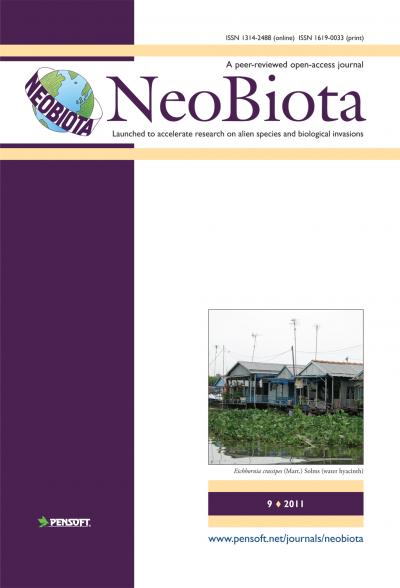Conditions在欧洲出现的黑树皮病和皮质隐孢子虫的空气生物学
IF 3
2区 环境科学与生态学
Q1 BIODIVERSITY CONSERVATION
引用次数: 2
摘要
黑树皮病(SBD)是影响欧洲梧桐槭(Acer pseudoplatanus)的一种新兴病害。据推测,原产于北美东部的致病因子皮质隐间质也可引起人类肺炎。它于1945年在欧洲首次被发现,自2000年以来报告数量显著增加。病原体的发展似乎与热浪和干旱事件有关。在这里,我们基于一个三十年的时间序列数据集分析了SBD在欧洲出现的条件。我们还通过法国的一项区域研究,比较了两年的空气生物学和流行病学数据,以及一项包括来自6个国家(捷克、法国、意大利、葡萄牙、瑞典和瑞士)的12个空气样本的大陆研究,利用一种物种特异性的定量PCR检测来评估空气生物学样本的适用性,以了解皮质虫的流行病学。我们发现,春夏季累积水分亏缺低于-132 mm与SBD爆发相关。我们的结果表明,皮质孢子是一种有效的空气传播病原体,它的分生孢子可以传播到离最近的疾病暴发地点310公里远的地方。在欧洲,C. corticale的有氧生物学遵循SBD的分布规律。在宿主原产地区和疾病存在时间较长的国家,如法国、瑞士和捷克共和国,病原体检出率很高,而在意大利,仅报告了一次病原体。葡萄牙和瑞典的样本中没有这种病原体,这两个国家尚未报告这种疾病。我们的结论是,空气生物学监测可以了解SBD的空间分布,并有助于在无病原体的国家早期发现。本文章由计算机程序翻译,如有差异,请以英文原文为准。
Conditions of emergence of the Sooty Bark Disease and aerobiology of Cryptostroma corticale in Europe
The sooty bark disease (SBD) is an emerging disease affecting sycamore maple trees (Acer pseudoplatanus) in Europe. Cryptostroma corticale, the causal agent, putatively native to eastern North America, can be also pathogenic for humans causing pneumonitis. It was first detected in 1945 in Europe, with markedly increasing reports since 2000. Pathogen development appears to be linked to heat waves and drought episodes. Here, we analyse the conditions of the SBD emergence in Europe based on a three-decadal time-series data set. We also assess the suitability of aerobiological samples using a species-specific quantitative PCR assay to inform the epidemiology of C. corticale, through a regional study in France comparing two-year aerobiological and epidemiological data, and a continental study including 12 air samplers from six countries (Czechia, France, Italy, Portugal, Sweden and Switzerland).
We found that an accumulated water deficit in spring and summer lower than -132 mm correlates with SBD outbreaks. Our results suggest that C. corticale is an efficient airborne pathogen which can disperse its conidia as far as 310 km from the site of the closest disease outbreak. Aerobiology of C. corticale followed the SBD distribution in Europe. Pathogen detection was high in countries within the host native area and with longer disease presence, such as France, Switzerland and Czech Republic, and sporadic in Italy, where the pathogen was reported just once. The pathogen was absent in samples from Portugal and Sweden, where the disease has not been reported yet. We conclude that aerobiological surveillance can inform the spatial distribution of the SBD, and contribute to early detection in pathogen-free countries.
求助全文
通过发布文献求助,成功后即可免费获取论文全文。
去求助
来源期刊

Neobiota
Agricultural and Biological Sciences-Ecology, Evolution, Behavior and Systematics
CiteScore
8.10
自引率
7.80%
发文量
0
审稿时长
6 weeks
期刊介绍:
NeoBiota is a peer-reviewed, open-access, rapid online journal launched to accelerate research on alien species and biological invasions: aquatic and terrestrial, animals, plants, fungi and micro-organisms.
The journal NeoBiota is a continuation of the former NEOBIOTA publication series; for volumes 1-8 see http://www.oekosys.tu-berlin.de/menue/neobiota
All articles are published immediately upon editorial approval. All published papers can be freely copied, downloaded, printed and distributed at no charge for the reader. Authors are thus encouraged to post the pdf files of published papers on their homepages or elsewhere to expedite distribution. There is no charge for color.
 求助内容:
求助内容: 应助结果提醒方式:
应助结果提醒方式:


